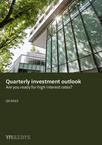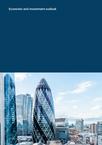The quarter-end numbers mask a significant amount of short-term volatility within the period, not least when the strength of banking was once again called into question and several banks had to be rescued as their business models faltered.
Gilts also had a positive quarter as bond markets continued to look pessimistically at economic prospects, hence forecasting lower interest rates this year. Gold, a traditionally safe haven rose over 8% in US Dollar terms.
When rumours of liquidity problems at Silicon Valley Bank (SVB) started to circulate amongst tech start-ups, the uninsured nature of many companies’ deposits triggered a good old-fashioned bank run. As the news filtered out, SVB failed to raise fresh equity and was forced to sell down (safe) assets at a loss, making their position even more precarious until the authorities had to step in to prevent a loss of confidence in the banking sector.
Whilst this was in some senses a classic run on the bank (albeit not with queues outside branches, but with withdrawals made via apps) the catalyst for the problem is perhaps more instructive about the state of the economy.
SVB had for the last few years taken in significant deposits from companies funded by private equity and venture capital. While these flows were positive, the liquidity mismatch on SVB’s books did not matter, but as liquidity in the private markets slowed and tech companies found it harder to attract fresh money that’s when problems began to emerge.
The banking system is much stronger now than in 2008, and authorities have again shown a preparedness to act to support it. We doubt that the same can be said for private markets and the companies that rely on them for funding.
Where economic stresses are appearing, they are generally associated either with inflationary forces, the rise in interest rates necessary to combat inflation, or indeed both.
Inflation is, as expected, coming down as rising energy costs fall out of the calculations, but core inflation remains stubbornly high as experienced inflation affects behaviours and in turn, expected inflation.
This phenomenon is most visible within labour markets, which, although easing slightly, remain tight, and in the UK are subject to widespread industrial action across the public sector. This is what Huw Pill, the Bank of England’s Chief Economist, has recently referred to as ‘Inflation Persistence’, and it is this concern which has caused central banks to maintain their hawkish rhetoric despite the market’s belief that interest rates will be cut this year.
In the face of these difficulties, one boost to global economic growth has been the reopening of the Chinese economy after their zero Covid policy was jettisoned. There were concerns that the reopening would boost demand and lead to further global inflationary pressures, but this hasn’t transpired, with activity primarily benefiting the services sector in a domestically focused rebound.
Elsewhere, other emerging market economies have benefitted from a weaker US Dollar, providing a further fillip to growth.
David Baker – Chief Investment Officer
Read our outlook
Who’s ready for high interest rates?
In economist-speak, ‘easy living’ has a name: interest rates. Consumers, companies and even governments have enjoyed an unusually extended period of low interest rates and money printing, dating back to the 2008 Global Financial Crisis.
This era ended abruptly in 2021. Inflation, the result of dislocations related to the pandemic as well as geopolitical shifts, seems poised to be with us for some time. As supplies of cheap goods dwindled, central banks needed to constrain demand, so that prices didn’t spiral out of control. To do that, they needed to increase interest rates. At the time of writing central banks have aggressively hiked rates and are nearing peak interest rates, with a pause eagerly anticipated by markets
However, this must not be construed as “easy money” coming back again. Interest rates are notoriously blunt instruments, and it takes time for their impact to be felt, slightly longer than nine months on average. Rate hikes began about one year ago, so we are just beginning to observe the consequences of a tighter money supply.
In this article, we examine how persistently low rates changed behaviour, where we think rates will go from here and which areas of the market are likely to be most affected by higher refinancing costs.
George Lagarias - Chief Economist
Read more
Our global economic outlook
The post-pandemic rebound has effectively been arrested and the global economy is slowing down.
Higher inflation, which is primarily supply-side driven, is causing demand to slow down and central banks to tighten the money supply. Macroeconomic visibility remains exceptionally low, as the post-pandemic world remains exceedingly volatile.
The US Federal Reserve, the world’s de facto central bank has remained hawkish, and it is leading other more dovish banks down the path of monetary tightening. Recent banking turbulence has moderated rate hawkishness, somewhat, but at the time of writing all major central banks (US, UK, EU, Japan), bar China, maintain this monetary outlook.
George Lagarias - Chief Economist
Read our global economic outlook
Our UK economic outlook
As global growth slows, the UK is widely expected to underperform against most of its developed market peers in 2023. According to the IMF, Britain is the only major G7 economy predicted to contract this year (-0.6% to -1.0%) whereas Europe and the US are poised to marginally grow.
In the short term, this is the result of higher inflation, as well as tighter fiscal and monetary policies and financial conditions. Longer-term, persistently low investment post-Brexit and labour shortages are both pushing prices higher (further constricting financial conditions) and limiting output.
High energy prices are weighing on household budgets. Following the 2022 mini-budget debacle and the consequent change in government, Chancellor Hunt is obliged to walk a very narrow fiscal path, which leaves no room towards the alleviation of consumer concerns.
George Lagarias - Chief Economist
Read our UK economic outlook
Sign up to our next economy webinar
Join our Chief Economist and Chief Investment Officer for an upcoming live webinar and Q&A session where they will discuss the global economy, markets and the investment landscape.
Webinar details
- Date: Wednesday 31 May
- Time: 10:00
- Duration: 45 minutes
Register here








